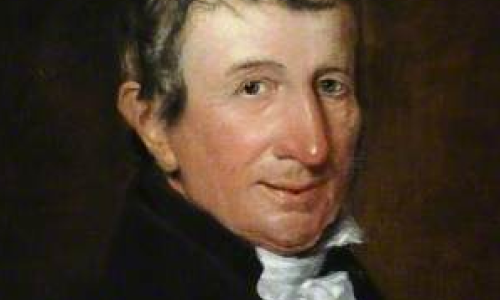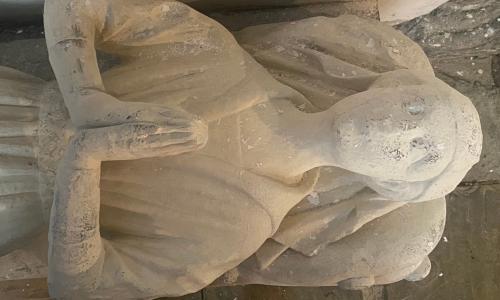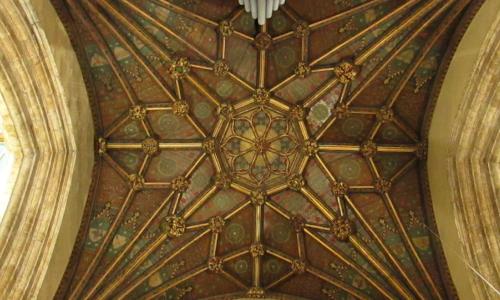What are the memorials for?
Memorials in the church come in all shapes and sizes, to remind us of the lives of people who have died. At Hull Minster there are memorials to individuals and to families, to aldermen, merchants and military people, to men, women and children.
Throughout the church, these memories of people are written on the stone ledgers on the floor, memorials on the walls and wooden screens, on furniture and in panels of stained glass. Looking carefully, you can see family history:
- when people were born
- where and when they died
- what their occupations were
- what their contribution to Hull was
- how they contributed to Holy Trinity Church.
Monuments were usually created by the family and friends of the dead and show words of love, kindness and respect. Many of them have beautiful poetry which is both inspiring and touching.
Careful inspection shows occupations which no longer exist, historic battle locations, or give a glimpse into historic life of Hull.
Some of the monuments are carved by eminent masons recognised by the Royal Academy. Among them John Bacon, Thomas Earle and Keyworth.
Conservation
Restoration of the monuments is an expensive job and can only be done by approved and apprenticed stone masons. Beautiful details come to light when the monuments are conserved. We undertake "honest repairs" which means that the stonework is not cleaned back to perfection to match the repair - the repair is visible. Monuments become a little dirty, but this is okay as it allows all the details to show clearly. The contrast in shades helps the detail to be seen from ground level.
The most common types of stone used at Holy Trinity include fine Italian marble, which can be wither very dark or very light, regional sandstone, granite and slate. All of these can break apart or degrade at some time, so need to be carefully monitored. Rusty iron which holds the monuments to the wall, has the power to break the stone and cause it to be unstable. Stainless steel is used today.
Effigies and tombs
The tombs of life-sized people are some of the Minster’s oldest memorials. They are made of alabaster and would probably have been painted in life-like colours when they were new.
Records of burials are not clear for this period of time and some early monuments have been moved around. This means that we can only guess who they represent by their clothing – costume-history helps us date them – and their occupation. The pair in the south choir aisle wall opening, probably husband and wife, are thought to be Robert and Emma Selby. Robert was a Mayor of Hull. Emma's brother, Richard Ravenser, was a prominent churchman, Archdeacon of Lincoln. Together, the Selbys and Richard paid for an almshouse (where the old, poor and infirm were looked after) on the north side of the church, where the market now stands, and a chantry chapel (for prayers and worship) inside the church.
Here is the description of them:
- The man is bearded and bare headed, lying with his head on two cushions. He wears mid-to-late fourteenth century clothes: a long, hooded mantle or cloak over a long gown. You can see all the buttons on the different layers and on his sleeves. On his belt hangs a wool prod, to check bales of wool: this shows he is a wool-merchant. His hands are in prayer and hold a book. His feet rest on a little lion.
- The woman wears a shoulder-length veil, wired at the front edge to make a square shape, holding it off her face. Her hair would be pinned up in a net underneath it. She has a long dress called a kirtle. Its tight sleeves are very long and cover part of her hands. Over this she wears a pleated gown or surcoat, with patterned edges and short wide sleeves. It is buttoned to the waist, then cut away to show the kirtle (probably a different colour). Extra folds of material on each side may mean she was wearing long mantle or cloak over this. Her head rests upon two cushions supported by angels (now damaged). At her feet is a dog.
One of the most recent memorials to the church is the Choristers' Memorial. Erected after World War 1 to remember the young men from the Choir School who perished in the war, it is made of oak and spans the whole aisle and is a fitting reminder of the loss of so many young people. Funds were raised via public appeal after the war to erect the memorial.
The location of the Choristers' Memorial has always been at the South Choir Aisle, but it was attached to the east wall until 2017 when it was moved forward to provide a storage cupboard behind. Upon removing the wooden screen, the construction company, Geo Houlton and Sons Ltd, found a large collection of small glass jars, heavily serrated and approximately the size of a light bulb. These were identified as Shipham’s meat paste jars.
There is no explanation as to why they were found there but several theories exist. Were they filled with tasty meat and rat poisoning and dropped behind the screen to kill rodents? Were they hidden evidence of a picnic feast? Were they used as target practice by choristers who lined them up and tried to knock them off the top of the memorial for fun?




